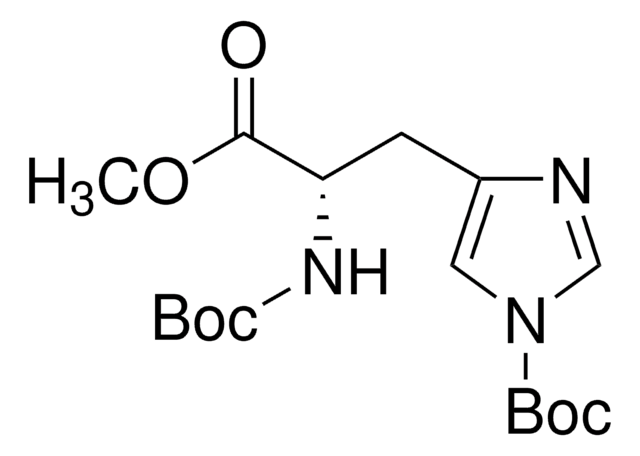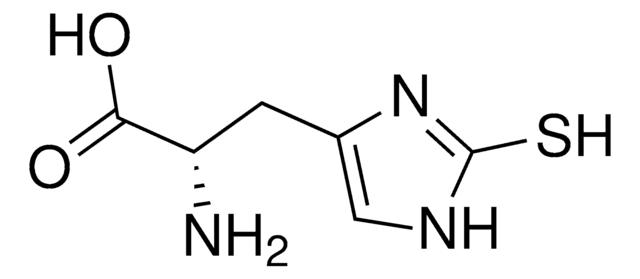おすすめの製品
アプリケーション
- Engineering mutually orthogonal PylRS/tRNA pairs for dual encoding of functional histidine analogues.: Exploring innovative genetic engineering techniques, this research advances the use of histidine analogues like 3-Methyl-L-histidine for producing novel proteins with enhanced functionalities, offering vast potential in therapeutic and industrial applications (Taylor et al., 2023).
- Improving the enzymatic activity of l-amino acid α-ligase for imidazole dipeptide production by site-directed mutagenesis.: This investigation enhances the enzymatic synthesis of imidazole dipeptides, crucial for understanding the role of modifications like those seen in 3-Methyl-L-histidine and its impact on biological activities (Kino et al., 2023).
生物化学的/生理学的作用
3-メチル-L-ヒスチジンは非タンパク新生アミノ酸であり、筋破壊の指標です。
保管分類コード
11 - Combustible Solids
WGK
WGK 3
引火点(°F)
Not applicable
引火点(℃)
Not applicable
個人用保護具 (PPE)
dust mask type N95 (US), Eyeshields, Gloves
適用法令
試験研究用途を考慮した関連法令を主に挙げております。化学物質以外については、一部の情報のみ提供しています。 製品を安全かつ合法的に使用することは、使用者の義務です。最新情報により修正される場合があります。WEBの反映には時間を要することがあるため、適宜SDSをご参照ください。
Jan Code
M9005-1G:
M9005-25MG:
M9005-BULK:
M9005-250MG:
M9005-VAR:
M9005-100MG:
試験成績書(COA)
製品のロット番号・バッチ番号を入力して、試験成績書(COA) を検索できます。ロット番号・バッチ番号は、製品ラベルに「Lot」または「Batch」に続いて記載されています。
この製品を見ている人はこちらもチェック
M N Goodman
The American journal of physiology, 260(5 Pt 1), E727-E730 (1991-05-01)
The metabolic response to infection includes loss of lean tissue and increased nitrogen excretion. The loss of muscle tissue during infection results in large part from accelerated skeletal muscle protein breakdown. Recent studies suggest that macrophage-derived products secreted during infection
E Roth et al.
Clinical chemistry, 31(8), 1305-1309 (1985-08-01)
We measured amino acid concentrations in plasma and skeletal muscle of three groups of patients with acute hemorrhagic pancreatitis: (a) patients without secondary organ lesions, (b) patients also suffering from kidney damage, and (c) patients in whom the pancreatitis was
Melanie J Edwards et al.
Journal of comparative physiology. B, Biochemical, systemic, and environmental physiology, 180(2), 247-257 (2009-09-04)
We fed common brushtail possums artificial diets containing a buffer and the plant secondary metabolite (PSM), orcinol, to test the hypothesis that organic acids, common products of PSM metabolism, limit feeding by common brushtail possums (Trichosurus vulpecula). We introduced several
M Hansen et al.
Scandinavian journal of medicine & science in sports, 21(1), 62-72 (2009-11-04)
Oral contraceptive (OC) treatment has an inhibiting effect on protein synthesis in tendon and muscle connective tissue. We aimed to investigate whether OC influence myofibrillar protein turnover in young women. OC-users (24±2 years; Lindynette® n=7, Cilest® n=4) and non-OC-users (controls
S G A van der Drift et al.
Journal of dairy science, 95(9), 4911-4920 (2012-08-25)
The objective of this study was to obtain information on variation between dairy cows in muscle and fat tissue mobilization around parturition and to study the association between protein and fat mobilization and serum β-hydroxybutyrate (BHBA) concentrations (hyperketonemia) in this
ライフサイエンス、有機合成、材料科学、クロマトグラフィー、分析など、あらゆる分野の研究に経験のあるメンバーがおります。.
製品に関するお問い合わせはこちら(テクニカルサービス)












